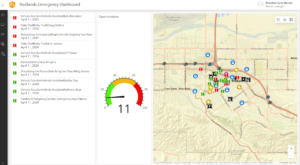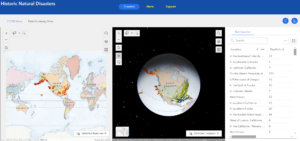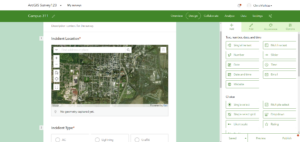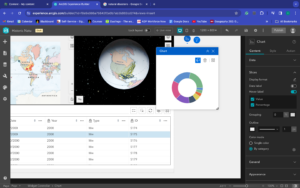Application idea: I think it would be interesting to create an application using the School District data set from the Delaware Data Inventory and use it to highlight the school districts in Delaware County and some of their accomplishments, mascots, facts, history, etc. I didn’t go to school around here, but I think this would be an interesting app for locals who are interested in the high schools around Delaware. If I could find it (if it’s even available), I could also do this using schools from the county where I am from so that it would feel a little more personal and relevant. This could be turned into something unique using the Experience Builder feature!
Chapter 3: Chapter 3 is all about learning to use the Experience Builder, which as I understand it, is a feature in ArcGIS Online that allows people to make unique and interactive web experiences without having to worry about too much coding! I think this a really cool concept that makes app building much more accessible and allows for more information to be shared. The book explains that you can choose from a template and pick the theme of your web experience, and then you can use multiple tools to design it the way you want.
Tutorial 3: This tutorial was an overview of how to use the ArcGIS Experience Builder to map an application about natural disasters. For the most part, it was pretty easy to follow and understand, but like other people, I ran into a few problems. It was interesting to see all the different widgets that are available to customize the web experience. I wasn’t able to link my Views Navigation to the 2D and 3D map, so there might be something buggy with this feature since other people appeared to have issues as well. I thought that the Dynamic Content feature in the Text widget was really cool to use. I had a little trouble with the SQL builder and I’m not quite sure I did it correctly. Tutorials 3.5 and on were a bit difficult because it built on stuff in 3.5 which I couldn’t quite get to work. However, I was able to do 3.1-3.4 easily, so I’m glad I got the basics of the Experience Builder so I can use it in the future because it is a really useful tool!
Chapter 4: This chapter is about Mobile GIS and some of the other ways you can utilize ArcGIS Online to reach a broader audience through phones, tablets, laptops, etc. Some of the terms they use in the introduction are a little out of my realm of knowledge, but I mostly understood that Mobile GIS is a very powerful and versatile tool. The ArcGIS Field Maps is a really interesting concept that could probably be used for some of the biology field labs that we offer here at OWU since it gives tasks and assignments based on locations. It is also interesting to see how VAR and AR can be incorporated into these applications for a very visual concept.
Tutorial 4: It’s a little hard to begin with all of the different GIS features because they all seem to have different names for the Panes and all of the tools are in new places each chapter. For example, in tutorial 4.1 I couldn’t find the Add Tab button in the location the book said it was. It’s a little frustrating when you can’t find something because then I had to skip most of the rest of 4.1 since it builds on the Add Tab direction, which wasn’t there. I wonder if sometimes they just update the names of the items on ArcGIS, but the book is a bit older. Sometimes I can work around the little differences, but since I’m not familiar with Survey123, I couldn’t find another feature to replace the Tab with. I also didn’t publish this Survey since it didn’t even have most of the things from the tutorial. I think this is an interesting concept, but I wish I was able to find the option to add the actual survey parameters. There were also a few things I couldn’t find in 4.3 like the Change Style button, but this was mostly doable. Some of the things I could find on a different tab than what the book specified. I wasn’t able to do the Expression builder in this chapter. I struggled with this in a previous chapter because the book has different directions than how the Expression builder is set up now, so I have no idea what I should be doing. The bad thing about this chapter is that every other tutorial requires you to try out the app you just built in the previous tutorial, but I haven’t been able to complete an entire app without some sort of issue, so I’m never able to try it out with the mobile app. The AR app was very cool! I was testing it out in my room, so I couldn’t completely see some of the POIs I put in, but it was still fun to test out.

















